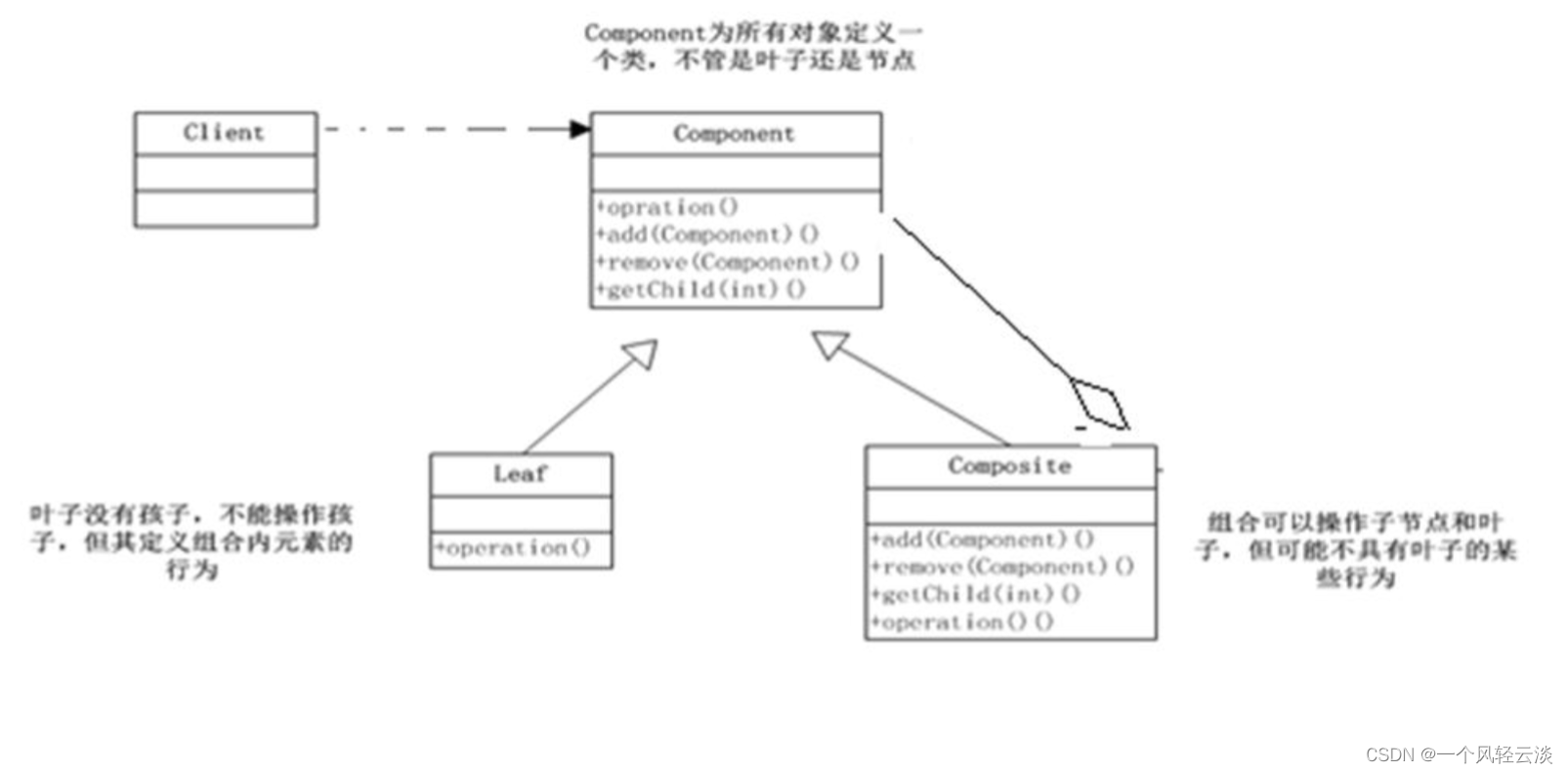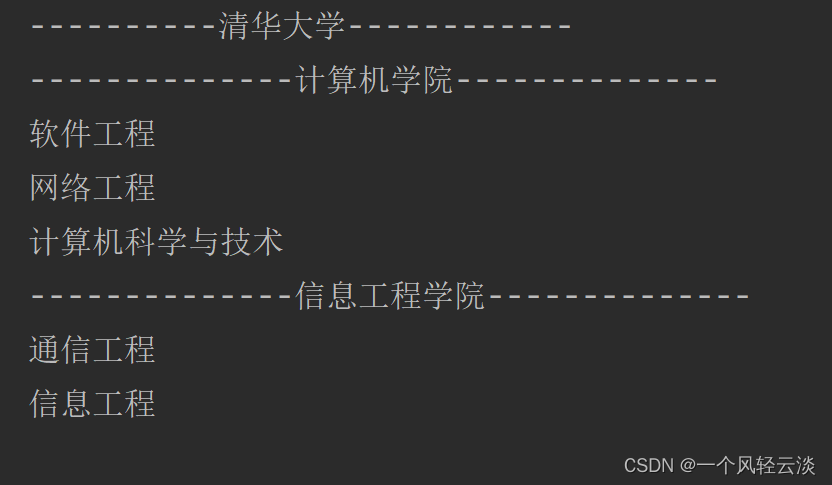组合设计模式解读


目录
问题引进
传统方案解决学校院系展示存在的问题分析
基本介绍
组合模式原理类图
对原理结构图的说明-即(组合模式的角色及职责)
应用实例
组合模式的注意事项和细节
问题引进
看一个学校院系展示需求
编写程序展示一个学校院系结构:需求是这样,要在一个页面中展示出学校的院系组成,一个学校有多个学院

传统方案解决学校院系展示(类图)

传统方案解决学校院系展示存在的问题分析
1) 将学院看做是学校的子类,系是学院的子类,这样实际上是站在组织大小来进行分层次的
2) 实际上我们的要求是 :在一个页面中展示出学校的院系组成,一个学校有多个学院,一个学院有多个系, 因此这种方案,不能很好实现的管理的操作,比如对学院、系的添加,删除,遍历等
3) 解决方案:把学校、院、系都看做是组织结构,他们之间没有继承的关系,而是一个树形结构,可以更好的实现管理操作。 => 组合模式
组合模式基本介绍
基本介绍
1) 组合模式(Composite Pattern),又叫部分整体模式,它创建了对象组的树形结构,将对象组合成树状结构以
表示“整体-部分”的层次关系。
2) 组合模式依据树形结构来组合对象,用来表示部分以及整体层次。
3) 这种类型的设计模式属于结构型模式。
4) 组合模式使得用户对单个对象和组合对象的访问具有一致性,即:组合能让客户以一致的方式处理个别对象及组合对象
组合模式原理类图

对原理结构图的说明-即(组合模式的角色及职责)
1) Component :这是组合中对象声明接口,在适当情况下,实现所有类共有的接口默认行为,用于访问和管理Component 子部件, Component 可以是抽象类或者接口
2) Leaf : 在组合中表示叶子节点,叶子节点没有子节点
3) Composite :非叶子节点, 用于存储子部件, 在 Component 接口中实现 子部件的相关操作,比如增加(add),删除。
应用实例
应用实例要求
1) 编写程序展示一个学校院系结构:需求是这样,要在一个页面中展示出学校的院系组成,一个学校有多个学院,
一个学院有多个系。
2) 思路分析和图解(类图)

OrganizationComponent
public abstract class OrganizationComponent {private String name;//名字private String des;// 说明protected void add(OrganizationComponent organizationComponent){throw new UnsupportedOperationException();}protected void remove(OrganizationComponent organizationComponent){throw new UnsupportedOperationException();}public OrganizationComponent(String name, String des) {this.name = name;this.des = des;}public String getName() {return name;}public void setName(String name) {this.name = name;}public String getDes() {return des;}public void setDes(String des) {this.des = des;}protected abstract void print();
}College
public class College extends OrganizationComponent {//List 中 存放的 DepartmentList<OrganizationComponent> list = new ArrayList<OrganizationComponent>();// 构造器public College(String name, String des) {super(name, des);}// 重写 add@Overrideprotected void add(OrganizationComponent organizationComponent) {//将来实际业务中,Colleage 的 add 和 University add 不一定完全一样list.add(organizationComponent);}// 重写 remove@Overrideprotected void remove(OrganizationComponent organizationComponent) {list.remove(organizationComponent);}@Overridepublic String getName() {return super.getName();}@Overridepublic String getDes() {return super.getDes();}// print 方法,就是输出 University 包含的学院@Overrideprotected void print() {System.out.println("--------------" + getName() + "--------------");//遍历 organizationComponentsfor (OrganizationComponent organizationComponent : list) {organizationComponent.print();}}
}
University
University 就是 Composite , 可以管理 College
public class University extends OrganizationComponent{List<OrganizationComponent> list= new ArrayList<>();public University(String name, String des) {super(name, des);}@Overrideprotected void print() {System.out.println("----------"+getName()+"------------");for (OrganizationComponent organizationComponent : list) {organizationComponent.print();}}@Overrideprotected void add(OrganizationComponent organizationComponent) {list.add(organizationComponent);}@Overrideprotected void remove(OrganizationComponent organizationComponent) {list.remove(organizationComponent);}}Department
public class Department extends OrganizationComponent{public Department(String name, String des) {super(name, des);}//没有集合@Overridepublic void setName(String name) {super.setName(name);}@Overridepublic void setDes(String des) {super.setDes(des);}@Overrideprotected void print() {System.out.println(getName());}
}client
public class client {public static void main(String[] args) {//从大到小创建对象 学校OrganizationComponent university = new University("清华大学", " 中国顶级大学 ");//创建 学院OrganizationComponent computerCollege = new College("计算机学院", " 计算机学院 ");OrganizationComponent infoEngineercollege = new College("信息工程学院", " 信息工程学院 ");//创建各个学院下面的系(专业)computerCollege.add(new Department("软件工程", " 软件工程不错 "));computerCollege.add(new Department("网络工程", " 网络工程不错 "));computerCollege.add(new Department("计算机科学与技术", " 计算机科学与技术是老牌的专业 "));infoEngineercollege.add(new Department("通信工程", " 通信工程不好学 "));infoEngineercollege.add(new Department("信息工程", " 信息工程好学 "));//将学院加入到 学校university.add(computerCollege);university.add(infoEngineercollege);university.print();}
}
组合模式的注意事项和细节
1) 简化客户端操作。客户端只需要面对一致的对象而不用考虑整体部分或者节点叶子的问题。
2) 具有较强的扩展性。当我们要更改组合对象时,我们只需要调整内部的层次关系,客户端不用做出任何改动.
3) 方便创建出复杂的层次结构。客户端不用理会组合里面的组成细节,容易添加节点或者叶子从而创建出复杂的树形结构
4) 需要遍历组织机构,或者处理的对象具有树形结构时, 非常适合使用组合模式.
5) 要求较高的抽象性,如果节点和叶子有很多差异性的话,比如很多方法和属性都不一样,不适合使用组合模式


